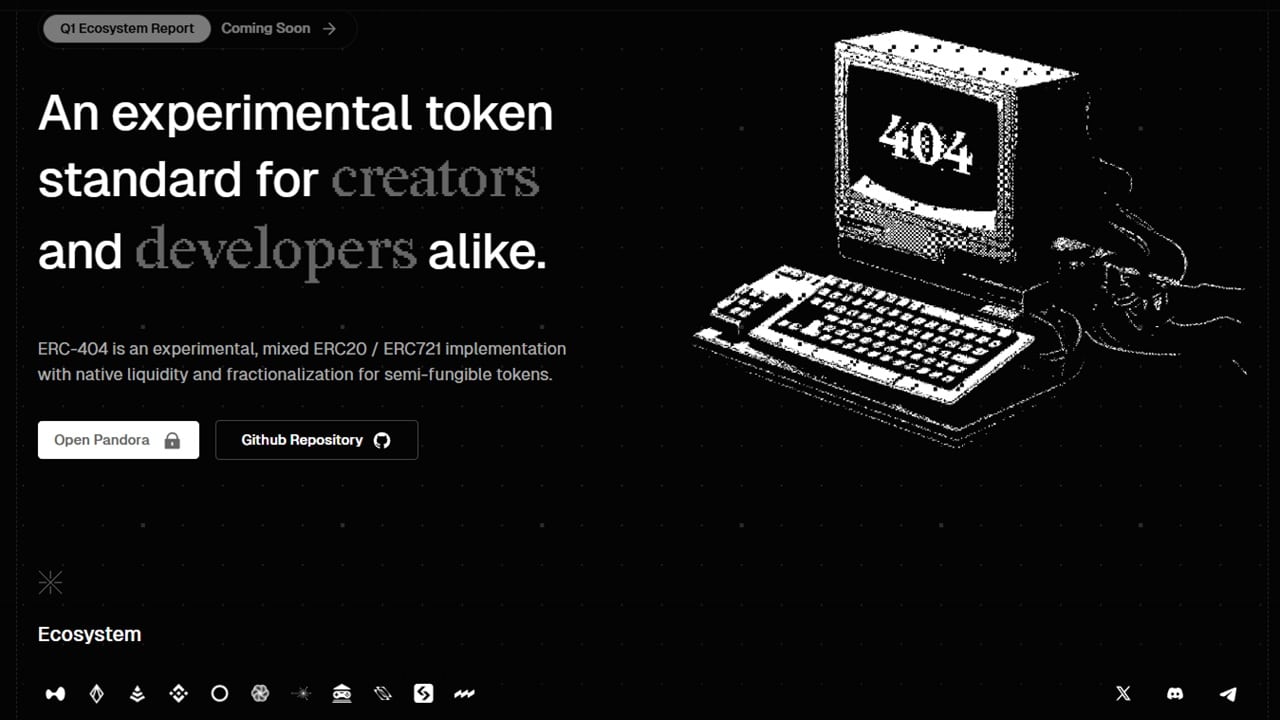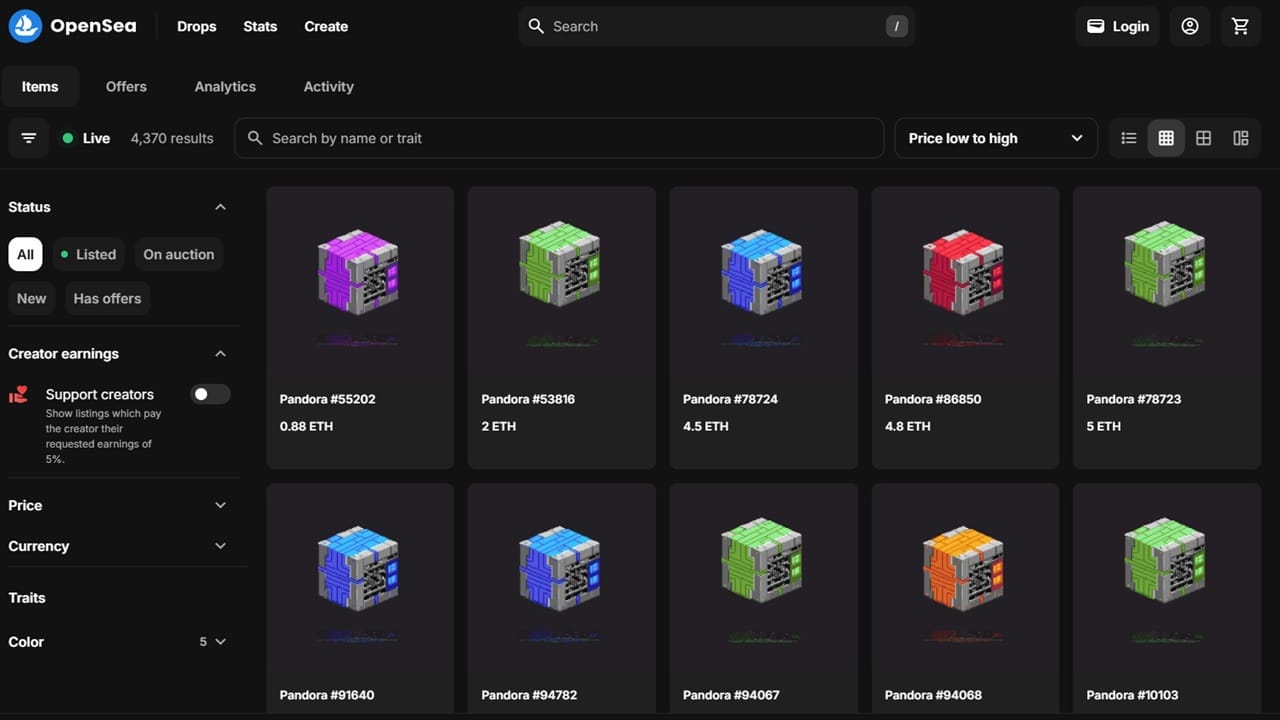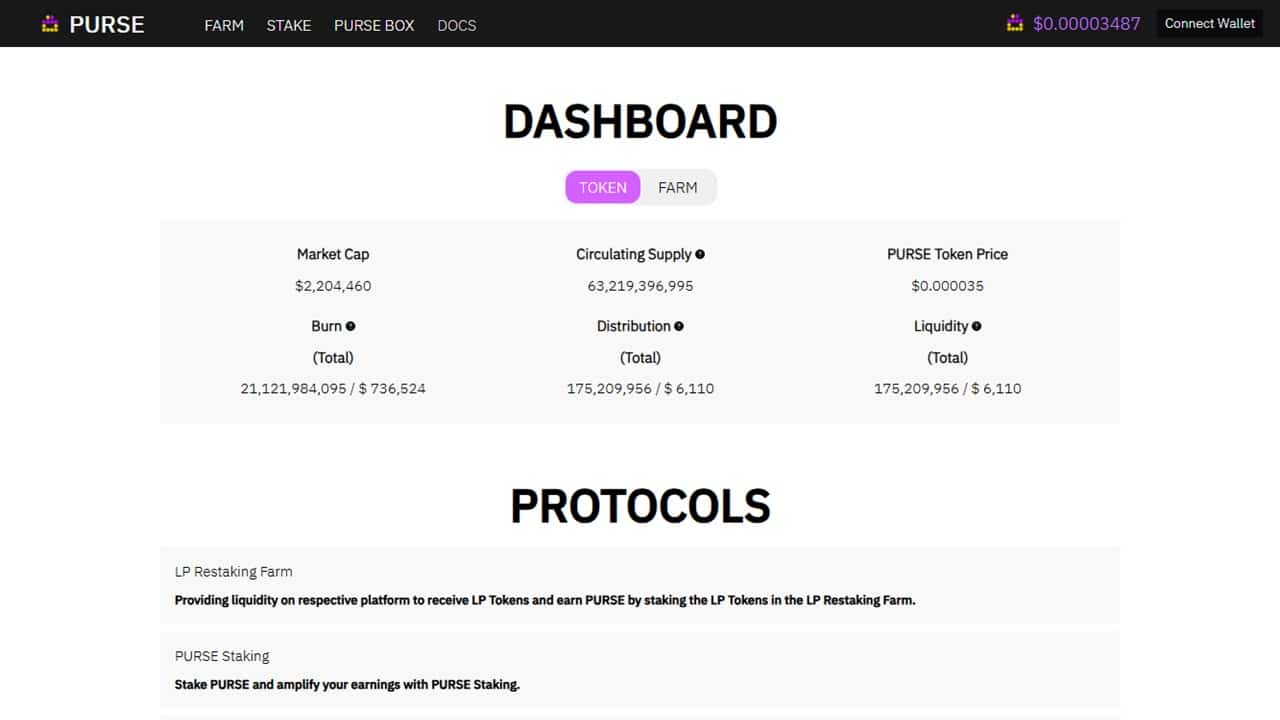The ERC-404 token is an experimental Ethereum smart contract standard and one of the newest developments within the blockchain ecosystem. The unofficial token standard bridges the gap between the popular ERC-20 (fungible token) and ERC-721 (non-fungible token) protocols, creating a unique semi-fungible standard.
ERC-404 solves the critical liquidity problem for NFTs, one of the most popular crypto assets in the Ethereum network. By enabling fractional ownership and seamless trading, the new Ethereum standard can unlock a new generation of accessible digital asset collectibles. Let’s review the best ERC-404 coins and explore the most promising projects to invest in.
Pandora Pundi X PURSE DeFrogs MYSTCL Froggy Friends OnChain Pepe 404 Crystal Dino Poker LOONG Memefi Toybox 404 Palette Pandora Finance
#
Coin
Price
24h %
Market Cap
Volume
24h Range
1
![]() Pandora
PANDORA
Pandora
PANDORA
$904.71
8.87%
$9,046,786
$1,875,709
2
![]() Pundi X PURSE
PURSE
Pundi X PURSE
PURSE
$0.0(4)50
-7.29%
$1,391,307
$18,638
3
![]() DeFrogs
DEFROGS
DeFrogs
DEFROGS
$65.85
0.45%
$658,566
-
4
![]() MYSTCL
MYST
MYSTCL
MYST
$39.57
0.14%
$276,976
$1,536
5
![]() Froggy Friends
TAD
Froggy Friends
TAD
$7.99
1.45%
$79,924
-
6
![]() OnChain Pepe 404
OCP404
OnChain Pepe 404
OCP404
$469.56
-
$41,322
-
-
7
![]() Crystal
CRYSTAL
Crystal
CRYSTAL
$43.93
-
-
-
-
8
![]() Dino Poker
RAWR
Dino Poker
RAWR
$2.62
-1.10%
-
-
9
![]() LOONG
LONG
LOONG
LONG
$39.00
2.13%
-
-
10
Memefi Toybox 404
TOYBOX
$10.17
-
-
-
-
11
Palette
PLT
$38.31
-9.56%
-
$41,296
12
Pandora Finance
PNDR
$0.0030
0.58%
-
-
![]()
![]()
![]()
![]()
![]()
![]()
![]()
![]()
![]()
Top ERC-404 Tokens
Here are the top 5 ERC-404 tokens to watch out for in 2025.
1. Pandora ($PANDORA)
Pandora Price Chart
(PANDORA)Pandora (PANDORA) is the first and largest ERC-404 token, spearheading the experimental implementation of a hybrid ERC-20 and ERC-721 smart contract. In 2024, it was launched by Pandora Labs and achieved a $250 million valuation at the height of its virality.
The pioneering ERC-404 crypto has a maximum supply of 10,000 tokens, which were created by combining 10,000 ERC-20 tokens and 10,000 ERC-721 tokens called “Replicants.” OpenSea, a leading NFT marketplace, sold hundreds of Pandora Replicants within the first few days of the project’s release.
Demand for PANDORA tokens has died down in the months following the project’s launch, leading to a 98% price correction. However, interested investors can still find Pandora listings on several mid-tier centralized exchanges (CEXs), including Biconomy.com, Gate.io, and OrangeX.
Find out more about Pandora
2. Pundi X PURSE ($PURSE)
Pundi X PURSE Price Chart
(PURSE)Created by Singaporean crypto payments company Pundi X Labs, Pundi X PURSE (PURSE) is an ERC-404 crypto envisioned to enhance merchant loyalty and rewards programs. PURSE builds on Pundi X’s native token, PUNDIX, enabling fractional ownership of NFTs.
Based on the PURSE official dashboard, the ERC-404 token has a $2.2 million market cap from a current circulating supply of over 63.2 million PURSE tokens. At the time of writing, users can stake their PURSE tokens and earn 10.43% APR (annual percentage return). Nearly 10 billion Pundi X PURSE tokens have already been staked, and stakers can claim their rewards at any time.
PURSE has a maximum supply of 258 billion tokens and operates on the native Pundi X Chain, BNB Chain (BEP20), Ethereum (ERC20), Base, and Tron (TRC20) blockchains. The cryptocurrency can be found on the PancakeSwap decentralized exchange (DEX) and Bybit and WOO X centralized exchanges.
Find out more about Pundi X Purse
3. Defrogs ($DEFROGS)
DeFrogs Price Chart
(DEFROGS)DeFrogs (DEFROGS) is another Pandora-inspired ERC-404 project, incorporating meme culture into the unofficial Ethereum token standard. Like its predecessor, it has a total supply of 10,000 tokens and experienced rapid growth within the first few days of its release.
The ERC-404 meme coin had a fair launch on February 6, 2024, where its tokens were listed on Uniswap. Today, investors can find DEFROGS tokens live on the MEXC centralized exchange and the Uniswap DEX. Additionally, DeFrogs NFTs are currently listed in the OpenSea NFT Marketplace with a total trading volume of 325 Ethereum (ETH).
Since DeFrogs’ token launch, the crypto’s price has not recovered from its all-time highs of $3,930.55 per token in 2024. With a market capitalization of nearly half a million dollars, DeFrogs remains a highly speculative asset as both a meme token and an experimental smart contract standard.
Find out more about Defrogs
4. MYSTCL ($MYST)
MYSTCL Price Chart
(MYST)MYSTCL (MYST) is the first PFP (profile picture) ERC-404 cryptocurrency operating on the Base network. Its NFTs are listed on various marketplaces, including OpenSea, Rarible, and Magic Eden.
Every whole MYST token is a unique and colorful NFT, adding to the project’s overall entertainment value. Furthermore, the creators of the MYSTCL project are the same developers of Whril.fi, an on-chain store of value built for market resilience, sustainable growth, and strong protection.
Much like the other ERC-404 cryptocurrencies on our list, general activity and trading surrounding MYSTCL have dropped significantly since the project was launched. The only platform selling MYST tokens publicly, based on CoinGecko, is the Uniswap DEX. You can follow the MYSTCL X profile for the latest updates.
Find out more about MYSTCL
5. Froggy Friends ($TAD)
Froggy Friends Price Chart
(TAD)Froggy Friends (TAD) is another Base network PFP project built on the ERC-404 experimental standard. Users who swap ETH for at least 1 unit of TAD will receive a Tadpole NFT from the Froggy Friends ERC-404 crypto.
Specifically, TAD tokens are supplementary NFTs from the main Froggy Friends NFT collection, featured on platforms like OpenSea and Magic Eden. The Tadpoles are cuter PFPs and went live on Base in September 2024.
According to BaseScan, Froggy Friends has a total supply of 8,888 TAD and over 2,500 holders. The project rebranded from ticker symbol “TADPOLE” to “TAD,” following its transition to the ERC-404 token standard that enabled NFT trading with lower gas fees.
Find out more about Froggy Friends
Best Wallet - Diversify Your Crypto Portfolio
- Easy to Use, Feature-Driven Crypto Wallet
- Get Early Access to Upcoming Token ICOs
- Multi-Chain, Multi-Wallet, Non-Custodial
- Now On App Store, Google Play
- 250,000+ Monthly Active Users
What Is ERC-404?
Blockchain development team Pandora Labs created the ERC-404 standard and announced the completion of the smart contract in February 2024. The goal was to fractionalize NFT ownership, increasing liquidity and accessibility across multiple platforms.

Compared to the traditional ERC-20 token standard, ERC-404 has non-fungible features that allow it to operate as an NFT protocol. However, the ERC-404 standard shares the ERC-20’s native liquidity and fractional ownership as opposed to the ERC-721 standard, which has very low liquidity and zero fractional ownership capabilities.
Here’s a side-by-side table comparison of ERC-404, ERC-20, and ERC-721 taken from Pandora Labs:
| Feature/Compatibility | ERC-404 | ERC-20 | ERC-721 |
| Fractional Ownership | Yes | Yes | None |
| NFT Protocol Interoperability | Yes | None | Yes |
| Native Liquidity | Yes | Yes | None |
| ERC-20 Protocol Interoperability | Yes | Yes | None |
| Non-Fungible Properties | Yes | Non | Yes |
| Official Token Standard | No | Yes | Yes |
As a hybrid token, ERC-404 uses a lot of internal logic in its architecture. Each ERC-404 token corresponds to a unique NFT ID; users can hold fractions of an ERC-404 token. Selling fractions removes the NFT through a smart burn mechanism, where the NFT is transferred to a pool of IDs.
Additionally, ERC-404 is an open-source token project that has yet to be recognized by the Ethereum Foundation for an EIP (Ethereum Improvement Proposal) to standardize the smart contract. Since anyone can freely use and access the ERC-404 Github repository, various cryptocurrencies have been developed using the ERC-404 structure.
The crypto community invested heavily in ERC-404 when it was first introduced. With the first-mover advantage, Pandora saw most of the earliest gains. However, the ERC-404 crypto category has since grown silent as various projects were abandoned, with the smart contract still in the testing phase.
Why Does ERC-404 Matter?
NFTs, or non-fungible tokens, are highly limited by their liquidity. Moreover, they often carry hefty price tags, making it even more difficult for retail traders to buy them. By adopting a hybrid token model, ERC-404 aims to make NFTs more liquid and accessible so that more new players can enter the marketplace.
Beyond basic trading and digital asset ownership, the ERC-404 standard opens the door for more DeFi (decentralized finance) applications with NFTs in ways the traditional ERC-721 token couldn’t. For instance, users’ ERC-404 NFTs could earn passive income by lending the fractional tokens or locking them up in DEX liquidity pools.
In gaming, NFTs have long been implemented in Web3 and metaverse applications for in-game asset ownership. The ERC-404 standard enables shared asset ownership of rare gaming items, allowing developers to create more complex and active digital economies within these virtual worlds.
How Does ERC-404 Work?
ERC-404 blends two popular Ethereum standards: ERC-20 and ERC-721, focusing on NFTs and liquidity. The crypto operates on both ERC-20 and ERC-721 protocols, while completely supporting fractional ownership and retaining a non-fungible nature.

According to the official documentation, ERC-404 lets token holders own fractional NFTs while retaining easy trading features like regular tokens. Through the carefully programmed smart contract, each whole ERC-404 token is tied to a unique NFT ID, similar to a regular NFT. However, ERC-404 tokens can be divided into fractions, like 0.2 or 0.6.
From Pandora Labs’s example, an owner with 7.2 ERC-404 tokens selling 0.3 tokens will pull their last received NFT ID as their account balance drops to 6.9 tokens. If the receiver does not get an entire token, the NFT ID is recycled into a pool of NFTs.
What are the Key Features of ERC-404 Tokens?
Now that we’ve discussed the core value of ERC-404 tokens, let’s break down the key aspects of the unique and experimental Ethereum standard.
1. Fractionalized NFT Ownership
As previously mentioned, one of the ERC-404 standard’s main properties is enabling fractions of NFTs to be owned and traded, similar to how users can own 0.2 ETH or 0.6 Bitcoin (BTC). When implemented, this could make high-end NFTs more accessible and affordable, increasing NFT marketplace activity.
Furthermore, decentralizing NFT ownership through ERC-404 tokens allows users to spread the costs and risks associated with the NFT. Community members can co-own NFTs, which could lead to greater engagement in the project.
2. Enhanced Liquidity for NFTs
Traditional NFTs are challenging to trade within a short period since the seller needs to find a buyer willing to purchase an exact item at a specific price. With fractional NFT ownership, ERC-404 tokens can be bought and sold like regular cryptocurrencies and easily integrated into centralized and decentralized exchanges for even greater exposure.

Essentially, ERC-404 brings NFTs into the DeFi ecosystem, unlocking staking, lending, and other DeFi activities for ERC-404 NFT holders. Instead of relying solely on low liquidity NFT marketplaces, ERC-404 users could simply trade their tokens in a trading platform.
3. Automated Token-NFT Pairing
Powered by its well-crafted smart contract, ERC-404 automatically links you to an NFT whenever your token balance reaches a whole token. Going below that amount, the NFT is removed while you keep a few fractional tokens. This simplifies the entire fractional NFT ownership process as users don’t have to manually mint or burn NFTs when trading.
Pros and Cons of ERC-404 Tokens
While the ERC-404 token has introduced a highly accessible crypto model that retains the uniqueness of NFTs, it’s still an experimental standard with inherent risks and limitations. Let’s explore both sides.
Advantages
- Solves NFTs’ long-standing liquidity and indivisibility problems.
- New opportunities for DeFi integration.
- Allow retail crypto investors to gain exposure to high-end NFTs.
- Unlock new economic models across popular crypto categories, including gaming, IP, RWAs and digital ownership.
Challenges
- Not an official Ethereum standard.
- Security and smart contract risks.
- Hard to distinguish between unsustainable hype and real functionality.
- Facing constant regulatory changes affecting cryptocurrency prices.
How We Chose the Best ERC-404 Tokens
To ensure that our list of the top ERC-404 tokens reflects actual value and relevance, we used the following criteria in our evaluations:
Project Credibility and Team
We started by researching the individuals and organizations behind each ERC-404 project. Transparent and well-known teams with a history of building blockchain applications show credibility and accountability.
As a result, we prioritized projects that reveal ownership of their work, real organic engagement, clear communication with their community, and show sustainable project goals. It is also not just about popularity but about experience with previous projects.
Technology and Smart Contract Security
We consider ERC-404 projects with secure, reliable, and transparent smart contracts because the fractionalization and hybrid model concepts are new technologies. Vulnerabilities, whether in the programming or logic, are common in decentralized applications.
Signs of potential scams or even weaknesses in the coding could cause investors to lose significant amounts of capital. For this reason, we looked for indicators that might reflect rushed development, unclear implementation, or unaudited smart contracts.
Community and Ecosystem Growth
Tokens backed by strong communities have more investment potential than those with inactive members. We also paid close attention to the quality of community engagement, evaluating how organic the user base is.
Additionally, we highlight ERC-404 projects used across platforms with ongoing developments, educational resources, and strong dialogue with their users.
Market Potential and Utility
Finally, we examined the real-world use case of ERC-404 projects and their place in the 2025 crypto market. Cryptos with strong functionality that solves an existing problem are more likely to reach mass market adoption.
Another critical metric in this regard is project sustainability. We assess the platform’s potential longevity to determine whether the crypto’s utility and token distribution remain relevant in the long term. This includes compatibility with popular crypto wallets, platforms, and DEXs.
How to Use ERC-404 Tokens
Given ERC-404’s hybrid functionality, it presents a unique opportunity for both NFT collectors and crypto traders. Regarding trading, users may approach ERC-404 tokens the same way they would with regular cryptocurrencies. They can buy and sell them on DEXs and CEXs, taking into account the high volatility and speculative nature.

With their token-paired NFTs, ERC-404 holders can unlock layered strategies that combine crypto exchange trading and NFT marketplace listing for better earning opportunities. For instance, ERC-404 users could pivot their strategies during unfavorable token trading conditions and lean more towards marketing their ERC-404 NFTs on various marketplaces.
ERC-404 cryptocurrencies can be utilized for more than trading and holding. They can also be introduced to staking pools, yield-generating protocols, and other lending markets in DeFi. While most DeFi applications remain experimental, the opportunity for passive income through ERC-404 tokens still exists.
The Future of ERC-404
Initially, ERC-404 sparked massive interest within the Ethereum community, but it remains an advanced experimental token standard. Whether it will gain formal recognition depends on how widely adopted the token becomes and whether developers are willing to pursue the EIP process.
So far, the momentum among developers and projects building with ERC-404 has stagnated. We believe that this sector in the cryptocurrency market will need a reinvigoration with a significant catalyst, perhaps backing from major crypto investors or a revolutionary update in the smart contract.
Still, ERC-404 has the potential to redefine how NFTs and DeFi interact. Future iterations or improvements could offer lower gas fees, better smart contract efficiency, and more use cases. The standard has already pushed innovation forward in meaningful ways, so further technological developments could open the door to greater opportunities.
ERC-404 Tokens FAQs
Is ERC-404 an official Ethereum standard?
ERC-404 is not an official Ethereum standard and is currently still in its experimental phase.
How does ERC-404 differ from ERC-20 and ERC-721?
ERC-20 tokens are fungible, meaning each unit is identical and interchangeable. ERC-721 tokens are non-fungible, meaning each token is unique and cannot be split (NFTs). ERC-404 combines both standards, enabling fractional ownership of NFTs and increasing the liquidity of non-fungible tokens.
Why is ERC-404 considered experimental?
Pandora Labs, the creators of the ERC-404 token, developed the smart contract with a developmental design. It is not part of Ethereum’s official standards and is still being introduced within the Ethereum ecosystem.
What are the best wallets for ERC-404 tokens?
ERC-404 tokens can be stored in EVM-compatible wallets, including Best Wallet, MetaMask, and Trust Wallet.
What are the risks of investing in ERC-404 tokens?
Buying ERC-404 tokens as an investment carries various risks, including regulatory uncertainty, high speculation, smart contract vulnerabilities, and limited adoption and support.
Can ERC-404 tokens be staked or used in DeFi?
ERC-404 tokens are live on DeFi applications like the Uniswap DEX. However, their use is limited to buying and selling through liquidity pools.
How can I verify if an ERC-404 token is legitimate?
Users can evaluate the legitimacy of an ERC-404 token project by verifying the smart contract address on Etherscan, finding security reviews or smart contract audits, reviewing official project links, and researching the project’s team and developers.
What are some real-world use cases for ERC-404 tokens?
An ERC-404 token’s real-world functionality relates to the utility of ERC-721, allowing users to buy parts of high-value NFTs, real-world assets, metaverse NFT assets, IP rights, and even tokenized property.
References
- Pandora Labs® (Pandora Labs)
- Pandora – Collection | OpenSea (OpenSea)
- PURSE Token (PURSE)
- Pandora Labs · GitHub (GitHub)
- Introduction – ERC404 (Pandora Labs)
- Non-Fungible Token (NFT): What It Means and How It Works (Investopedia)